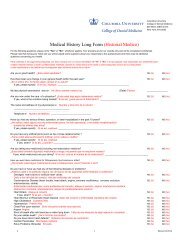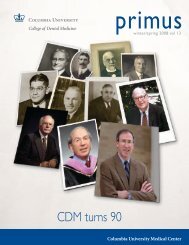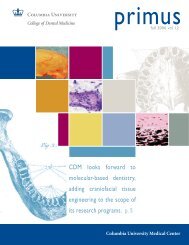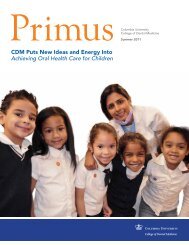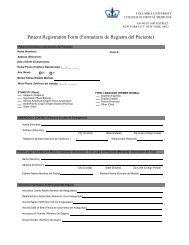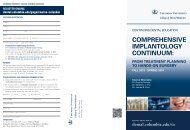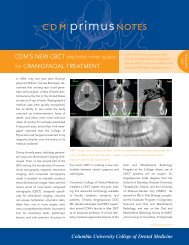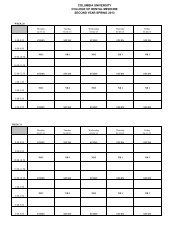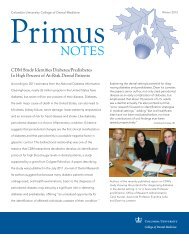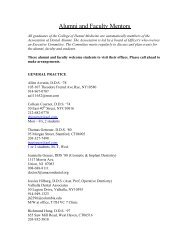Jarvie Journal - College of Dental Medicine - Columbia University
Jarvie Journal - College of Dental Medicine - Columbia University
Jarvie Journal - College of Dental Medicine - Columbia University
Create successful ePaper yourself
Turn your PDF publications into a flip-book with our unique Google optimized e-Paper software.
Volume 56, Spring 2013<br />
Incidence <strong>of</strong> Interproximal Open Contact Related to Implant Placement<br />
Posteriorly and Anteriorly<br />
Spyridon Varthis 1 ; Dennis P. Tarnow 2 ; Anthony Randi 3 *<br />
1<br />
Postgraduate Prosthodontics, <strong>College</strong> <strong>of</strong> <strong>Dental</strong> <strong>Medicine</strong>, <strong>Columbia</strong> <strong>University</strong> NY, NY<br />
2<br />
Implant Dentistry, <strong>College</strong> <strong>of</strong> <strong>Dental</strong> <strong>Medicine</strong>, <strong>Columbia</strong> <strong>University</strong> NY, NY<br />
3<br />
Division <strong>of</strong> Prosthodontics, <strong>College</strong> <strong>of</strong> <strong>Dental</strong> <strong>Medicine</strong>, <strong>Columbia</strong> <strong>University</strong> NY, NY * Faculty Mentor<br />
Introduction: The loss <strong>of</strong> Interproximal Contact between fixed implant prostheses and adjacent<br />
teeth has recently been reported. This is significant since patients <strong>of</strong>ten complain <strong>of</strong> food<br />
impaction. Chronic food impaction may lead to periodontal defects and recurrent decay. In order<br />
to prevent implant-tooth periodontal sequelae and tooth decay, a new proximal contact may have<br />
to be established between the prosthesis and adjacent tooth. Due to a lack <strong>of</strong> sufficient research<br />
on this topic, it is important to determine the incidence <strong>of</strong> Interproximal Contact Loss (ICL) and<br />
identify causative contributing factors. Upon completing the research, clinical guidelines may be<br />
established to prevent Interproximal Contact Loss and proper informed consent.<br />
Objective: The aim <strong>of</strong> this study is to determine the incidence <strong>of</strong> open contacts between single<br />
implant prostheses and adjacent teeth.<br />
Materials and Methods: Patients between the ages <strong>of</strong> 19 and 91, both male and female were<br />
included in this pilot study. The period <strong>of</strong> evaluation after implant restoration insertion was<br />
between 3 months and 11 years.<br />
The participants were seen at random intervals in order to identify Interproximal Contact Loss.<br />
The interproximal contacts were evaluated by using dental floss. Contact was considered open if<br />
floss passed without resistance from adjacent teeth. ICL was also confirmed visually.<br />
Results: Overall ICL was 48%. 77% were on the mesial surfaces and 23% on the distal. ICL<br />
was noted 44% in the maxilla and 56% in the mandible . The posterior region was affected 89%<br />
versus 11% in the anterior region. Among the incidents <strong>of</strong> ICL a significant percentage <strong>of</strong> 47%,<br />
presented food impaction and almost 42% <strong>of</strong> the patients were aware <strong>of</strong> the ICL.<br />
Discussion: The ICL rate was 48%. The mesial drifting caused by the interproximal wear <strong>of</strong><br />
natural teeth, mesial migration, occlusion and parafunctional habits are possible causative factors<br />
<strong>of</strong> ICL<br />
Conclusions: 48% <strong>of</strong> implant restorations demonstrated ICL. This results dictates that ICL<br />
should be included as an implant complication. The high incidence <strong>of</strong> ICL is justification for<br />
proper informed consent. The high incidence <strong>of</strong> ICL and associated clinical problems need to be<br />
addressed. Further research is necessary to identify causative factors for ICL. The authors suggest<br />
the use <strong>of</strong> an Essex retainer in order to prevent the IC loss between the implant restoration and<br />
adjacent tooth. Evaluation <strong>of</strong> IC between the implant restoration and adjacent tooth should be<br />
periodically monitored.<br />
53



